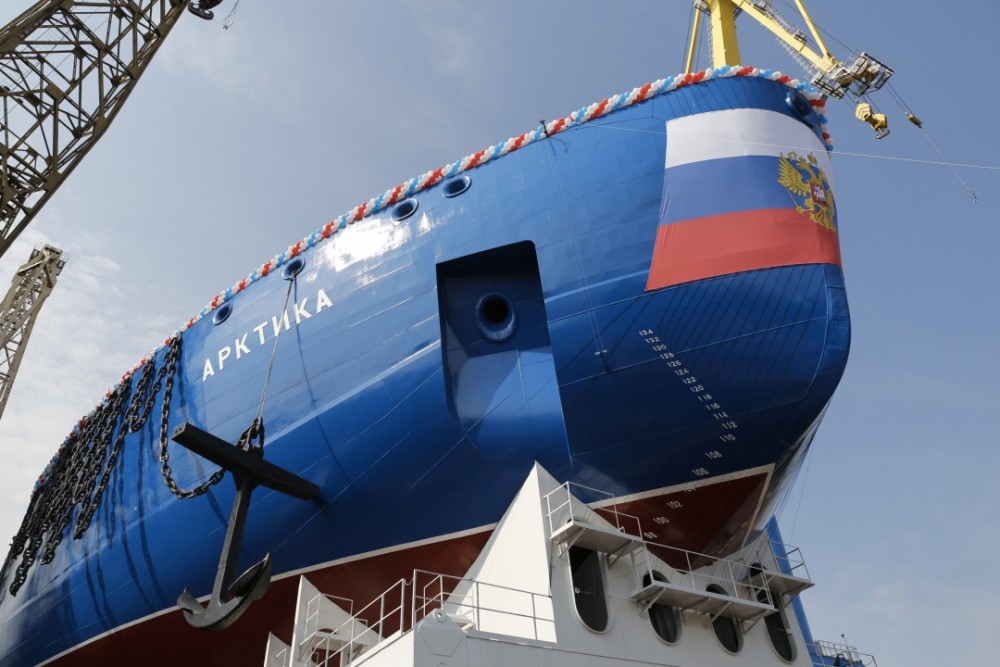
New Managing Director for Bellona Norway
The Board of the Bellona Foundation has appointed former Minister of Climate and the Environment Sveinung Rotevatn as Managing Director of Bellona No...
News

Publish date: June 20, 2016
News
Russia’s new Arktika nuclear icebreaker has put to water at St. Petersburg’s Baltika Shipyard, heralding a new line of icebreakers for Russian state nuclear corporation Rosatom that will be used primarily for clearing oil drilling areas in the Arctic.
Billed by official Russian media as “the most powerful icebreaker ever built,” the Arktika exceeds standard dimensions, weighing in at 173 meters long, 34 meters wide, and with a water displacement of 33,540 tons. It is also able to break through ice three meters thick.
It’s powered by two RITM-200 nuclear reactors, each with a capacity of 175 megawatts, making it by far the world’s most powerful ship of it’s kind, the Independent Barents Observer reported.
Some 700 people worked in shifts around the clock to finish the hull of the vessel, said the portal.
 The Arktika's hull on water in St. Petersburg. (Photo: gov.murman.ru)
The Arktika's hull on water in St. Petersburg. (Photo: gov.murman.ru)
Rosatom chief Sergei Kiriyenko, who was present at the ceremony to launch the Arktika onto the water said the boat “definitely opens new possibilities for our country,” according to a Rosatom release (in Russian).
Putting the hull of the Arktika on water has been delayed twice. It was first scheduled to hit water in December. That was pushed back to May
According to Vyacheslav Ruksha, head of Russia’s icebreaker port Atomflot the Arktika will be ready for operations by end December 2017, beating Rosatom predictions by a number of months.
Ruksha, while speaking at a conference entitled Atomic Energy in the Arctic: Ecology and Safety last month in Murmansk indicated the new line icebreakers would be used to assist in oil exploration in the Arctic.
“In the future, the new icebreakers will facilitate access to our hydrocarbon resources in countries of the Asian Pacific area,” he told the conference.
The Artika and is new generation cousins had previously been touted as necessary for guiding cargo through the Northern Sea Route. But Ruksha acknowledged at the conference that there primary goal was now assisting oil drillers.
The new policy for the icebreaker drew surprise from Nils Bøhmer, Bellona’s executive director.
“Well it is not very surprising if you have study the actual numbers on transit and cargo passing through the entire Northern Sea Route,” said Bøhmer. “But it is surprising coming from Ruksha – is this a signal of new Russian policy?”
If so, it may point to a policy that may be doomed to failure. Last month, Royal Dutch Shell, ConocoPhillips and numerous other oil majors abandoned drilling plans in the US Arctic after spending more than $2.5 billion dollars and a decade to ramp up their Arctic drilling programs.
 Eni Norway and Statoil's Goliat rig in Arctic waters. (Photo: Statioil)
Eni Norway and Statoil's Goliat rig in Arctic waters. (Photo: Statioil)
The costs associated with drilling in harsh climates and bringing that crude to market when oil is hovering around $30-$40 per barrel just won’t pay the bills, numerous analysts have said.
Still, Russia and Norway are taking their Arctic gambles. In March, Norway’s Statoil and Italy’s Eni positioned their Goliat rig – the northernmost in the world – in the Barents Sea and put it into service.
Russia, however was the first to drill the Arctic with state corporation Gazprom’s storied Prirazlomnoye platform situated in the Pechora Sea. In 2014, the rig produced 70,000 tons of substandard, low cost crude blend called ARCO, which it sold to France’s oil giant Total.
The new line icebreaker will fill the shoes of others that are headed for decommissioning, Ruksha said.
The nuclear icebreakers Sibir, Arktika and Rossiya are in cold shutdown. The Yamal would face the same fate if its reactor’s operation time is not extended in 2018, Ruksha told Bellona.
The Sibir is already headed to the metal bone yard. Ruksha told Bellona the vessel will be hauled from Atomflot to the Nerpa Shipyard in June for full dismantlement, which is expected to be complete by 2017.

The Board of the Bellona Foundation has appointed former Minister of Climate and the Environment Sveinung Rotevatn as Managing Director of Bellona No...

Økokrim, Norway’s authority for investigating and prosecuting economic and environmental crime, has imposed a record fine on Equinor following a comp...

Our op-ed originally appeared in The Moscow Times. For more than three decades, Russia has been burdened with the remains of the Soviet ...

The United Nation’s COP30 global climate negotiations in Belém, Brazil ended this weekend with a watered-down resolution that failed to halt deforest...